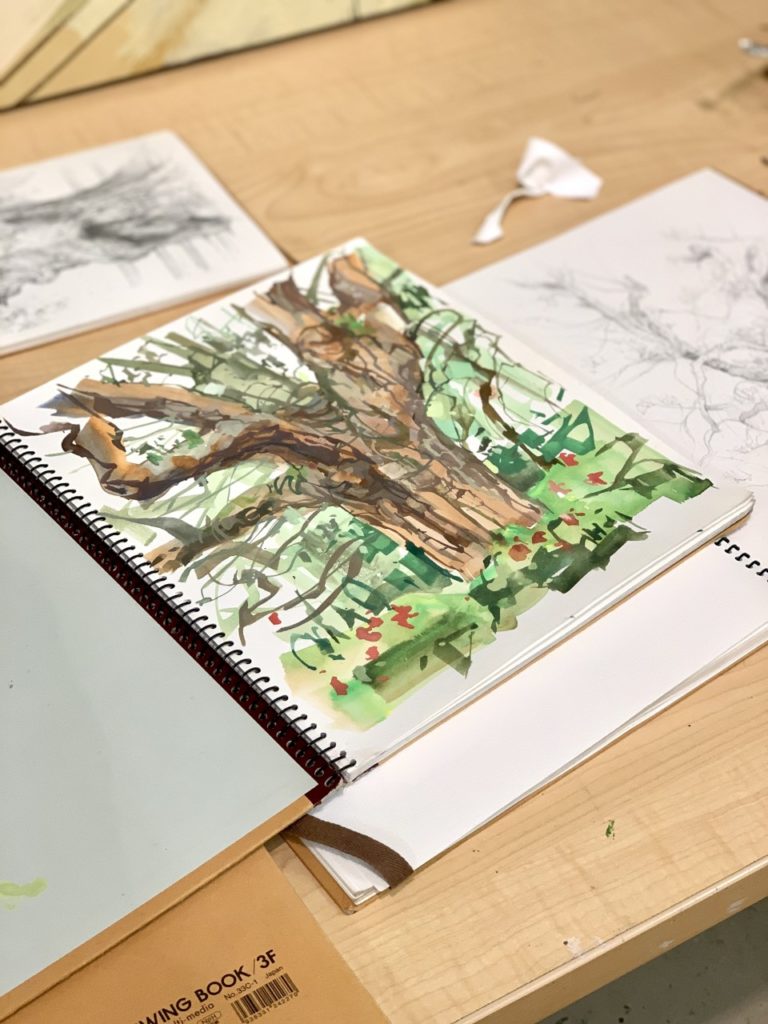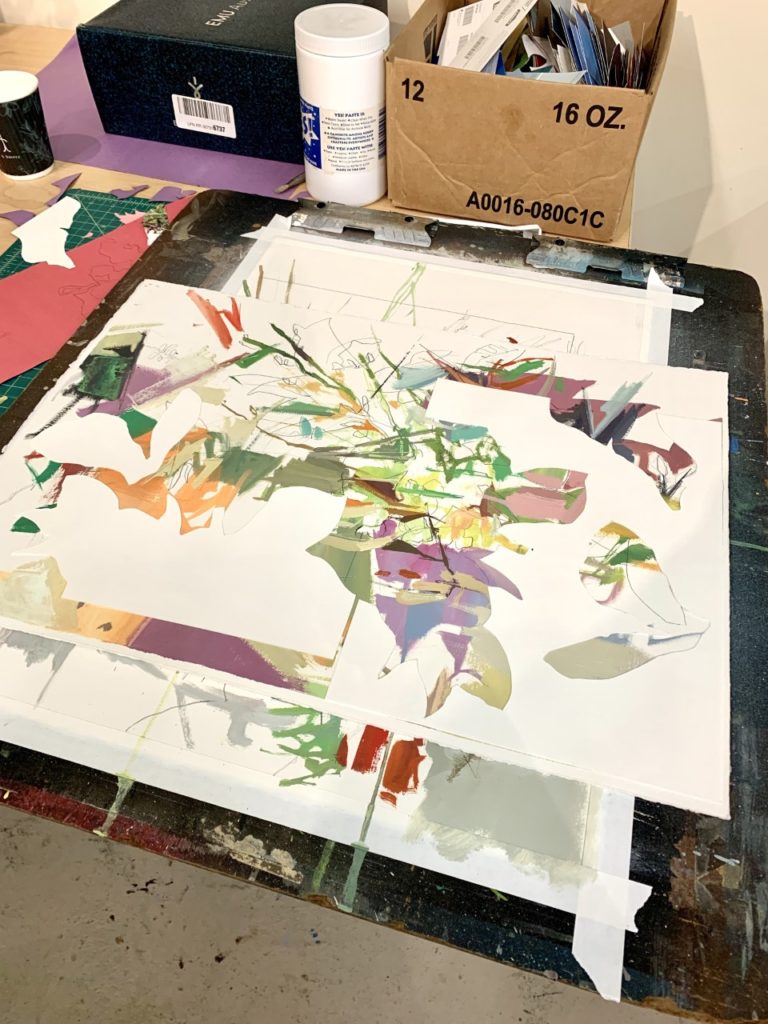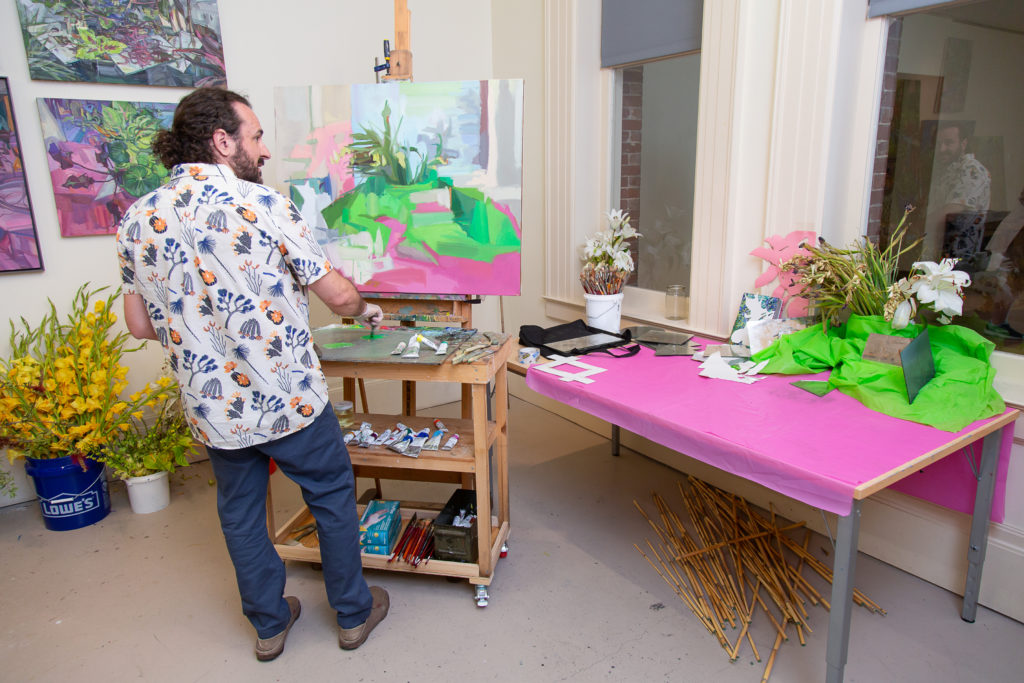Interviewed by Erin Glaze, Director of Contemporary Initiatives and Public Engagement
Francis Sills was born and raised in central New Jersey, relocating to Charleston, SC in May of 2011. Exposed to the wonders of the natural world at an early age through hiking and fishing, his childhood was spent drawing and constructing things out of cardboard. Both his grandfathers were good with their hands; one as a watercolorist, the other with carpentry and building. His ongoing series “The flora” utilizes the flowers and plants from his home garden. Some are painted plein air while others are in containers brought into the studio and juxtaposed with various shaped mirrors and objects. During his residency, Francis continued augmenting the reality of the flora through set ups, which both multiplied the forms and fractured the studio space. Museum Visitors encountered paintings that began to grow alongside the plants and flowers in front of them. Below, Francis shares how nature has always been an influence, his advice for aspiring artists, and how his studio practice continues to evolve.
Erin Glaze [EG]: Hello Francis, thank you for speaking with me today and answering some questions to conclude your residency at the Gibbes. It was wonderful having you in the studio during the month of May. Let’s begin with early influences.
Is your work informed by certain concepts or themes from your childhood, where you lived or were raised? How does this impact how you see the world and create art?
Francis Sills [FS]: I would say, broadly, probably the landscape is something I tapped into early in my childhood. I grew up in central New Jersey, pretty much old farm country. A lot of woods with creeks and ponds were around me. I have vivid memories of waking up early before dawn to go trout fishing with my dad too. I was probably very cranky at that time in the morning, being in 5th or 6th grade, but watching the light sort of change with the sun coming up and the mist coming off the water, it sparked a general interest in watching these patterns emerge through the current in the water and the rocks in the riverbeds. Since moving to Charleston ten years ago, my wife and I have built up our garden and my most recent series of paintings are inspired by this landscape at home.
[EG]: What role do you think the artist has in society?
[FS]: I think the artist can perform many functions. Pointing out beauty in the world, providing social commentary, or telling a story. I think of my work as being mostly formal, in the sense that I am mimicking or accessing the beauty found in Nature first and foremost. Big picture stuff, I feel the goal of the artist is to make people think about Life and to feel emotions. That can range from awe and wonder to anger and rage over injustice. There’s an infinite amount of experiences people go through in the world so art is a way of shining a spotlight on those experiences.
[EG]: I am sure being a teacher you try to put that into the minds of students as well. As they are learning, there’s so much influence and pressure on what needs to be tackled at the moment.
[FS]: It is a lifelong pursuit, figuring out what your work is about. Gradually, those “taught” influences fall away with trial and error as well as going through different life experiences.
[EG]: How has your practice changed over time?
[FS]: I guess as far as paintings, I was not doing colorful, floral pieces five years ago. Coming from Brooklyn, my work there was focused on gritty, urban cityscapes. My studio was near the Gowanus Canal in an industrial area known for its blight and neglect. When I moved here I tried finding similar motifs with high vantage points to continue this content, but we are in the Lowcountry and the effect wasn’t the same. Charleston is such a “pretty” city and it seemed false somehow to pursue that. I tried doing cityscapes for awhile in downtown Charleston and gradually shifted to the local landscape, going more towards the elements in nature that were specific to Charleston and the surrounding area. I live near Shem Creek so I was doing a lot of harbor scenes, or the majestic live oak trees, or paintings in black water swamps. I wanted my paintings to become brighter and more colorful so that is where the focus on plants and flora originated. Now I am making more still life constructions in my studio utilizing plant forms and different elements from my garden landscape.

[EG]: What work do you most enjoy doing?
[FS]: I am actually really enjoying the collage process right now. In grad school, from 1999-2001 at Parsons, I was making collages utilizing photocopies of my paintings and other elements that I placed on the photocopy machine. I would manipulate the photocopies and the objects as they scanned, giving me images that were distorted and unpredictable. I would then create these wall installations as a sort of still life, incorporating the photocopies and actual objects and draw from them. And now I find myself diving back into that practice…it is weird how things come around full circle with the work. I have been using paper and paint swatches to create color studies and the sketches for my paintings. I go to the paint store a lot and walk out with like a hundred paint swatches which I can cut up and add to the still life paintings as a way to investigate color and pattern. I think of these works as a playful activity, not as precious as a painting. It is also very tactile being able to cut and tear into the materials and build them up and rearrange them. So we will see where this goes.

[EG]: What jobs have you done other than being an artist?
[FS]: After college, I moved to Brooklyn and I got a job at a company in Manhattan that made handmade wallpapers. I was the color mixer and it was a pretty mindless job. I would be given a paint swatch and told to make ten gallons of one color. Most people would probably be driven nuts by this, but for me it was a great way to study color and get really good at mixing paint. I also worked for a furniture company doing faux finishes. It introduced me to the interior design world. It was fun and hands on and I was working with other artists, learning to use paint in a trompe l’oeil type of way. Then, I worked for a decorative painting company doing plaster finishes and murals. So I did that for most of the time I was in New York, and for a period of time owned a decorative painting company working in both residential and commercial spaces. I painted whenever I could, but it was tough because my studio time had dwindled and that was where my heart was . So, after living for 15 years in New York, my wife and I decided to move our family to Charleston. And this is when I pivoted to focusing on my painting more and eventually teaching at the College of Charleston.
[EG]: Was teaching art always a goal?
[FS]: Yes, totally, it was why I went to grad school. It is maybe every painter’s dream to get a stable paycheck, talk about painting all day and pass the torch of knowledge over to the next generation and get the summers off. While in New York, there were like a million artists competing for like eight teaching jobs so when we moved to Charleston it was not something I initially sought out, but it happened serendipitously. I had a connection through another adjunct professor, whose child went to school with mine, and they introduced me to John Hull, who was head of the Art department at the time. So now, I have been doing that for almost ten years. After painting for twenty-five years, you have to remind yourself that what is intuitive to you now is totally new for the student. I really enjoy it though, it has made me more articulate about what I am doing in the studio and given me clarity about my own work.
[EG]: Who are some artists that you would like to be compared to?
[FS]: Paul Cézanne is one of my favorites. When I began learning to paint at Syracuse University there was an older student in one of my classes who came to the US from Spain with nothing but a Cézanne book. We would stay up late into the night in the studio and paint and look at this book together. He would point out to me what made Cezanne so great and his decisions about color and form. Cezanne was always bouncing off and reacting to Nature. I am the type of artist who needs to see something, and then respond to it. As much as I love, say, Joan Mitchell or Willem de Kooning, who just can stand in front of a blank canvas and pull everything out of themselves, I need to see something in front of me visually and then react to it. I use my perception as a starting point to make paintings. Lucian Freud was also a big influence early on. I tend to like the European/French Impressionist and early modernist tradition. I love the colors, the light, the patterns, as well as their reliance on Nature.
[EG]: Is the artistic life lonely?
[FS]: No, well, [laughter] I have a family, so I’m not lonely but I love my studio time and time by myself too. My happy place is at my easel or in front of a sketchbook. It is solitary, for sure, and you have to accept that you do this work alone, but it doesn’t have to be lonely. It is important to pull out of the isolation and see people, and to be social.

[EG] Are there ways you stay connected to the arts industry/other artists outside of your regular bubble?
[FS]: I try to go to openings and functions, that is key. Social media is a great way to see what other people are doing in their studios. I feel like I find a new artist that is doing something interesting on Instagram almost every week. I have found that Zooming with friends has been a cool way to connect with people during the pandemic. And, I usually go back to New York at least once or twice a year to see exhibitions or gallery shows or just to visit other artists in their studios.
[EG]: I have noticed you listen to music a lot while painting. Are you drawn to a specific genre?
[FS]: Yes, well, I have not put on my usual psychedelic hippy rock music [laughter] while I’m here at the Gibbes…that’s an acquired taste. I really like jazz; mostly 1950s and 60s stuff like Miles Davis, John Coltrane and Thelonius Monk – so that is mainly what you’ve heard when visiting me.
[EG]: What is your dream project?
[FS]: I would really love to do some more large-scale paintings outside. My largest en plein air garden painting has been about four by five feet…so I would say something bigger than that would be really challenging. I watched that documentary on David Hockney where he did those gigantic multi panel landscape paintings in the English countryside…that was very inspiring.
[EG]: What’s holding you back?
[FS]: Courage and storage space[laughter]
[EG]: What’s the best piece of advice you’ve received?
[FS]: I would say know yourself, find out what you are most passionate about and don’t try to put on anybody else’s “garments.” Find out what delights you and excites you. That is really what other people will see in your work.
[EG]: What did you enjoy most about being an artist in residence at the Gibbes Museum of Art?
[FS]: I enjoyed eating pastries and drinking cappuccinos from The Harken like everyday [laughter], but no, on a serious note, the size of the space has been amazing to display this many works at once. Usually, they get stored away, or automatically sent to a gallery. So, being able to work around all of these paintings and see them all interact together has been great.
You can follow Francis Sills’ work at www.francissills.com and on Instagram @francissills.
Top image: Portrait of Francis Sills, Studio Two at the Gibbes Museum of Art, May 2021, MCG Photography
Posted June 17, 2021

